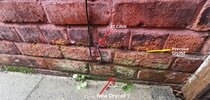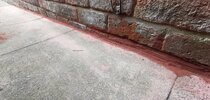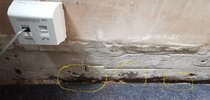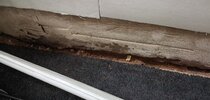I am about to fit new skirting but there is still just one area where water is seeping into the plaster. On closer inspection I think the problem is the sloping path adjacent to the wall outside is quite high up in the area (around the BT socket) and perhaps I needed to Dryrod (I installed them last year) that area lower as the bricks are clearly green below the previous dryrods.
I have since pointed all the gaps in the bricks and along the line where the concrete slabs meet the wall. Unfortunately after almost 2 weeks those damp patches are still visible inside. I just need to find a solution before I fit the skirting as it will only rot the wood over time again.
Included are images of the before and after outside pointing and cleaning of bricks (moss etc) with diagram of where Dryrods were installed and possibly more could be added. As well as the view inside of same area showing damp patches.
After 2 weeks have elapse I hope to re-apply stormdry to the bricks, and also to the pointing over the slabs making it watertight.
I have since pointed all the gaps in the bricks and along the line where the concrete slabs meet the wall. Unfortunately after almost 2 weeks those damp patches are still visible inside. I just need to find a solution before I fit the skirting as it will only rot the wood over time again.
Included are images of the before and after outside pointing and cleaning of bricks (moss etc) with diagram of where Dryrods were installed and possibly more could be added. As well as the view inside of same area showing damp patches.
After 2 weeks have elapse I hope to re-apply stormdry to the bricks, and also to the pointing over the slabs making it watertight.






